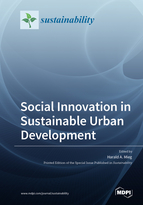Social Innovation in Sustainable Urban Development
A special issue of Sustainability (ISSN 2071-1050). This special issue belongs to the section "Sustainability in Geographic Science".
Deadline for manuscript submissions: closed (31 December 2021) | Viewed by 47514
Special Issue Editor
Interests: sustainable urban development; innovation; revitalization of urban industrial sites; financing urban infrastructure
Special Issue Information
Dear Colleagues,
How can a city advance from social invention to social innovation to attain sustainable urban development (SUD)? Many new ideas, initiatives, and showcases for social innovation have been introduced; however, this kind of project-based experimentation is often just part of the ongoing urban politics (or governmentality) and lacks sustainability, with traditional siloed city administrations remaining a central obstacle to SUD. In Mieg and Töpfer (2013), we therefore claimed that cities need greater institutional innovation.
For this Special Issue, we invite contributions on sustainable social innovations related to SUD. We welcome submissions on topics such as: (1) new, successful models of urban governance for city administration and SUD (cf. Angelidou and Psaltoglou, 2017); (2) the role of design for SUD (cf. Manzini, 2014); (3) innovation forms and discourses on social vs. technological innovation (cf. Edwards-Schachter and Wallace, 2017): smart cities, responsible research and innovation (rri), digital commons, etc.; (4) diffusion of social innovation (cf. BEPA, 2010): multi-level governance, rural–urban regional systems, game changers, etc.; (5) the moral dimension of social innovation: Do we need better citizens or better institutions?
Angelidou, M., & Psaltoglou, A, (2017). An empirical investigation of social innovation initiatives for sustainable urban development. Sustainable Cities and Society, 33, 113–125.
BEPA Bureau of European Policy Advisers. (2010). Empowering people, driving change: Social innovation in the European Union. Publications Office of the European Union.
Edwards-Schachter, M., & Wallace, M. L. (2017). ‘Shaken, but not stirred’: Sixty years of defining social innovation. Technological Forecasting & Social Change, 119, 64–79
Manzini, E. (2014). Making things happen: Social innovation and design. Design Issues, 30, 57–66.
Mieg, H. A., & Töpfer, K. (Eds.). (2013). Institutional and social innovation for sustainable urban development. Earthscan.
Prof. Dr. Harald A. Mieg
Guest Editor
Manuscript Submission Information
Manuscripts should be submitted online at www.mdpi.com by registering and logging in to this website. Once you are registered, click here to go to the submission form. Manuscripts can be submitted until the deadline. All submissions that pass pre-check are peer-reviewed. Accepted papers will be published continuously in the journal (as soon as accepted) and will be listed together on the special issue website. Research articles, review articles as well as short communications are invited. For planned papers, a title and short abstract (about 100 words) can be sent to the Editorial Office for announcement on this website.
Submitted manuscripts should not have been published previously, nor be under consideration for publication elsewhere (except conference proceedings papers). All manuscripts are thoroughly refereed through a single-blind peer-review process. A guide for authors and other relevant information for submission of manuscripts is available on the Instructions for Authors page. Sustainability is an international peer-reviewed open access semimonthly journal published by MDPI.
Please visit the Instructions for Authors page before submitting a manuscript. The Article Processing Charge (APC) for publication in this open access journal is 2400 CHF (Swiss Francs). Submitted papers should be well formatted and use good English. Authors may use MDPI's English editing service prior to publication or during author revisions.
Keywords
- social innovation
- sustainable urban development
- institutional innovation
- urban governance
- city administration
- policy experimentation
- multi-level governance
- rural–urban regional systems
- game changers
- smart cities
- responsible research and innovation (RRI)
- digital commons
- social responsibility






